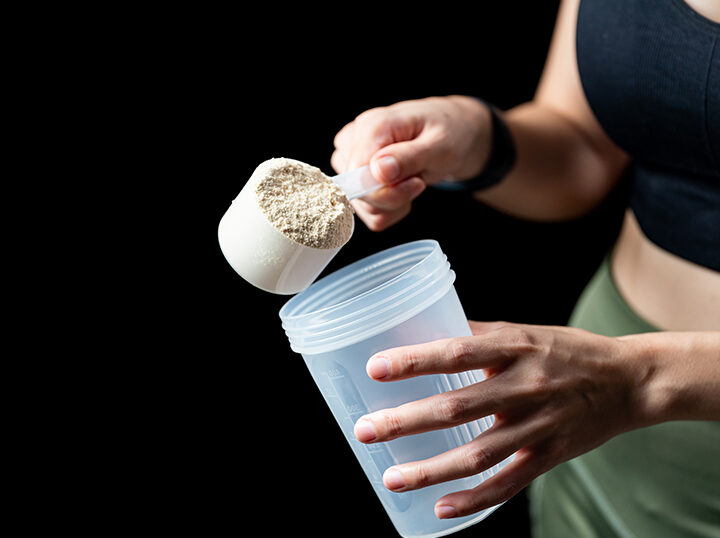The Truth About Creatine: The Most Underrated Longevity Supplement Or Hype?

Is it time to make like a musclehead and down some creatine?
This compound does far more than bulk up biceps; it’s almost unbelievably potent for [lon-jev-i-tee]nounLiving a long life; influenced by genetics, environment, and lifestyle.Learn More. Research shows creatine can help preserve muscle, improve endurance, support glycemic control, and even boost memory and cognition.
In fact, it might be one of the most impactful and safest supplements for extending [helth-span]nounThe number of years you live in good health, free from chronic illness or disability.Learn More. It’s been used and studied as a supplement for decades—so creatine is the opposite of a fly-by-night miracle cure. Still, scientists are continuing to learn more about how supplementing this naturally-occurring substance can improve our health.
Here’s a breakdown of what creatine is, how it works, and how to incorporate it into your daily routine for lasting strength and brainpower.
What Is Creatine, Really?
You may have read that creatine is an amino acid, but that’s not quite right: Your kidney and liver make creatine from amino acids, specifically glycine, arginine, and methionine. Creatine also enters our bodies through poultry, red meat, and seafood. Once made or eaten, about 95 percent of creatine is stored in muscle tissue.
Creatine is the opposite of a fly-by-night miracle cure.”
That storage points to its primary function: helping your body regenerate ATP (adenosine triphosphate), the energy currency of cells. Your body runs on the nutrients from food, but it does so, in large part, by converting those nutrients into ATP. In the same way that crude oil needs to be refined into gasoline, your body refines sugars and other molecules into ATP to power the engines of your body. When your cells use ATP, it degrades into something called ADP and phosphate. Creatine binds with the phosphate, letting the body resynthesize, or restore, ATP. When it’s restored, your body has more gas in the tank, so you can do more.
How Creatine Helps Build Strength at Any Age
Athletes often use creatine to push harder and build more muscle. It can increase high-intensity performance by 5 to 10 percent.
But the benefits go beyond the weight room. A 2017 meta-analysis of 721 adults ages 57–70 found that creatine supplementation combined with resistance training resulted in an average of three pounds more [leen mas]nounMuscle and other non-fat tissues that contribute to physical function.Learn More gained versus training alone.
With age-related muscle loss, or [sar-koh-pee-nee-uh]nounAge-related loss of muscle mass and strength.Learn More, as one of the key saboteurs of our health span, contributing to frailty and falls, that muscle gain is—if you’ll excuse the pun—huge. But it’s not just [strength tray-ning]nounResistance-based exercise to build muscle and support healthy aging.Learn More stamina that makes creatine potent for thriving as we age. It’s got other longevity-boosting benefits that have nothing to do with pumping iron.
Check out our Super Age Video Breakdown of the Benefits of Creatine
Five Surprising Health Benefits of Creatine
- Creatine can help with muscle even if you don’t strength train. A review of 143 studies showed gains in muscle and reductions in fat mass without lifting weights.
- It enhances endurance recovery. When taken after an exhausting bout of exercise, creatine can create a “super compensation” of muscle glycogen, a storage of carbohydrates in the blood. This means that the next time you exercise, there’s more energy in the tank than you could normally hold, so you could potentially go for longer.
- It may reduce fall risk. When scientists have participants perform strength training regimens with and without creatine supplementation, both groups get better at a sit-to-stand test, which has been shown to be a good predictor for the risk of falling. But those who train with the creatine improve more: A meta-analysis of studies on this found that the creatine-supplemented strength participants improved their performance in the test by 23 percent, compared to 17 percent for those training without creatine.
- It improves glycemic control. Glycemic control is how well our bodies can handle blood glucose that’s dumped into the bloodstream when we eat. The more of that glucose we can use, sucking it up into muscles to use as fuel or storing it as glycogen, the less insulin our body needs to process it, and the less glucose is stored as fat. In addition to helping our bodies overfill our glycogen stores, which uses up sugar, creatine may also create or move more of a protein called GLUT-4 transporters onto the surface of our muscle cells. These GLUT-4s act like little windows that let sugar molecules from our bloodstream into the muscles, where the glucose can be used to make ATP. Better glycemic control can fend off diabetes. And for patients who already have Type-2 diabetes, creatine supplementation has been shown to lower HbA1c.
- It boosts brain function. While most of your body’s creatine is stored in the muscles, there’s also some in your brain. According to an analysis of 16 studies published in 2024, a little more creatine in the noggin’ might be better: Creatine supplementation was shown to improve memory, and the speed of cognitive processing (though not general cognition). The effect was slightly larger in women.
There’s also promising research showing benefits for neurological diseases like Parkinson’s and Alzheimer’s with creatine supplementation in mice, but not, so far, in humans.
How Much Creatine Should You Take?
Your body needs about 1–3 grams of creatine per day. But we lose around 2% daily through urine, and most people don’t consume enough through diet alone.
That’s where supplements come in. Creatine is well-studied and safe for most people. In the past, some worried that supplementing with creatine could harm the liver or kidneys, but decades of research has shown that it’s generally safe. If you have kidney disease or diabetes, talk to your doctor before starting a creatine regimen.
When taking creatine supplements, the idea is to raise the amount that’s circulating in your bloodstream all the time—aiming for about 3 grams in the body. To get to that level, there are two popular dosing strategies.
Two dosing options:
1. Loading phase: Load up for 5-7 days, then maintain with a smaller dose. This is the most popular protocol; exercisers ingest 20 grams of creatine per day for 5-7 days, during the “loading phase.” After that, they dial it back to 2-5 grams per day (usually 5) going forward. That smaller dose is maintained long-term.
A version of this load-then-maintain protocol is recommended by the International Society of Sports Nutrition (ISSN) for muscle gain, with a weight-related tweak: For the loading phase, the ISSN says to take four doses per day during the loading phase, each measuring 0.3 grams per kilogram of your bodyweight.
2. No loading: Just take 3 grams per day. This dosing strategy takes a little longer to work. Instead of increasing your chronic creatine levels within a week, it can take around four weeks.
How to Start Taking Creatine
Starting a creatine regimen couldn’t be easier: Most creatine supplements are tasteless powders that mix easily into water or smoothies. Some companies are now also offering creatine in gummy candies, but there aren’t head-to-head studies showing how well the creatine in these gummies absorb into your bloodstream.
The timing of your creatine intake might matter for maximum absorption, but scientists really don’t agree on when that timing is. A few studies have shown that creatine is better absorbed when taken before a workout versus after the workout. The idea here is that your blood’s flowing more around your muscles during the workout, delivering the creatine where you want it to wind up. But most studies that have demonstrated this effect were in young people, and haven’t been replicated in older folks.
And other studies show the opposite, with creatine taken after a workout absorbing better. The idea here is that your cells are more open to sucking up that creatine-y goodness.
One thing that does improve absorption is taking your creatine with some carbohydrates and protein. The idea here is that eating food stimulates the insulin effect, moving sugar (with creatine) around your body to your muscle cells, where it gets picked up.
The most important thing seems to be taking creatine consistently, so the levels in your blood stay consistently up, letting creatine do its long- and short-term work.
So, keep it simple: If you’re starting a creatine regimen and you’ve talked to your doctor about it, take 3-5 grams of creatine daily when it’s convenient for you. Try taking it with food after you exercise or, if that’s not convenient, whenever it fits into your day.
The information provided in this article is for educational and informational purposes only and is not intended as health, medical, or financial advice. Do not use this information to diagnose or treat any health condition. Always consult a qualified healthcare provider regarding any questions you may have about a medical condition or health objectives. Read our disclaimers.

